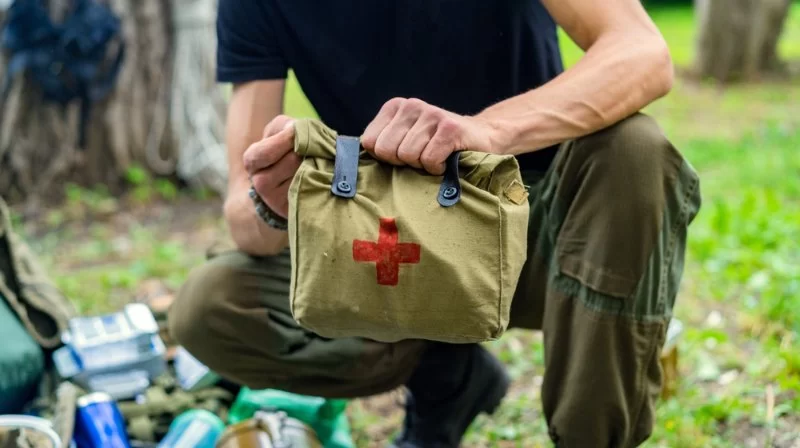1- What is Wilderness First Aid?
Wilderness first aid refers to the ability to handle medical emergencies in remote outdoor settings where professional help may be delayed or unavailable. Whether you're hiking in the mountains or camping deep in the woods, understanding wilderness first aid is crucial for ensuring safety and managing injuries or illnesses. Knowing the basic principles can make a significant difference in the outcome of an emergency situation.
2- Why Wilderness First Aid Matters
In wilderness environments, help is often far away, and emergency services might take hours to reach you. This is where wilderness first aid knowledge becomes invaluable. It equips you with the skills needed to stabilize a person until proper medical assistance can arrive. The importance of this knowledge is not limited to first responders; anyone venturing into nature should have basic wilderness first aid training.
2.1- Essential for Outdoor Enthusiasts
For outdoor enthusiasts, such as hikers, climbers, and campers, learning wilderness first aid is a fundamental part of outdoor preparedness. Knowing how to assess the situation, treat injuries, and keep calm in a stressful situation can mean the difference between life and death. It's especially important when the nearest hospital or clinic is several hours away.
3- Key Wilderness First Aid Principles
Understanding the core principles of wilderness first aid will help you handle a wide range of emergency situations effectively. Here are the basic principles that guide wilderness first aid:
3.1- The ABCs of First Aid: Airway, Breathing, Circulation
In any emergency situation, your first priority should be to check the person’s airway, breathing, and circulation. The ABCs of first aid represent the three critical components of assessing a person’s condition:
- Airway: Ensure the person’s airway is clear of obstructions.
- Breathing: Check if the person is breathing. If not, begin CPR if necessary.
- Circulation: Check for signs of circulation, like a pulse. If there's no pulse, CPR may be required.
3.2- Stop Bleeding and Prevent Infection
Bleeding is one of the most common injuries in wilderness settings. Knowing how to stop bleeding quickly is vital to prevent further complications. Apply pressure to the wound using a clean cloth, and if bleeding is severe, use a tourniquet as a last resort. After controlling bleeding, keep the wound clean to prevent infection by using antiseptic wipes and bandages when available.
3.3- Treat for Shock
Shock is a life-threatening condition that can occur after trauma or blood loss. Symptoms of shock include pale skin, rapid breathing, and weakness. If you suspect shock, keep the person warm and in a comfortable position, and seek professional help immediately. Maintaining their body temperature and comfort is crucial until help arrives.
4- Common Wilderness Injuries and How to Handle Them
During outdoor adventures, various injuries may occur. Here are some common injuries and how to handle them using wilderness first aid techniques:
4.1- Sprains and Strains
Sprains and strains are common injuries in wilderness environments, especially when hiking or climbing. To treat a sprain or strain, follow the R.I.C.E method:
- Rest: Allow the affected area to rest and avoid putting weight on it.
- Icing: Apply ice to reduce swelling and pain.
- Compression: Wrap the injury with a bandage to control swelling.
- Elevation: Keep the injured area elevated to reduce swelling.
4.2- Hypothermia
Hypothermia occurs when the body loses heat faster than it can produce it, usually in cold and wet conditions. Signs include shivering, confusion, and slurred speech. If you suspect hypothermia, move the person to a warmer area, remove wet clothing, and cover them with blankets or warm clothing. Offer warm fluids, but avoid alcohol or caffeine.
5- Practical Wilderness First Aid Kits
Having a well-equipped first aid kit is essential for any wilderness adventure. Your first aid kit should be tailored to the environment you’ll be in and the type of activities you plan to do. A good wilderness first aid kit should include:
- Bandages, gauze, and adhesive tape
- Antiseptic wipes and ointments
- Pain relievers and allergy medications
- Elastic bandages for sprains
- Cold packs and emergency blankets
- Personal medications
6- Training for Wilderness First Aid
While knowledge is important, hands-on training is essential for mastering wilderness first aid. Taking a certified wilderness first aid course will teach you practical skills and give you the confidence to manage emergencies in remote areas. Training also helps you react calmly and quickly when the situation arises. Local organizations, outdoor groups, and online courses offer great opportunities to gain the necessary skills.
7- When to Seek Professional Medical Help
While wilderness first aid can help stabilize an injured person, seeking professional medical care is often necessary, especially for severe injuries. Always know your location and have a plan for contacting emergency services or getting to the nearest medical facility if needed. Knowing when to seek help can save lives in critical situations.
8- Conclusion: Being Prepared Is the Key
Wilderness first aid knowledge is essential for anyone who enjoys outdoor activities. Understanding basic principles like the ABCs of first aid, knowing how to manage common injuries, and having a well-stocked first aid kit can help you handle emergencies confidently. Training and preparation are key to ensuring both your safety and the safety of those around you. Visit Pine Cliff Resort for more outdoor safety tips and to explore activities that keep you connected with nature in a safe and responsible way.







